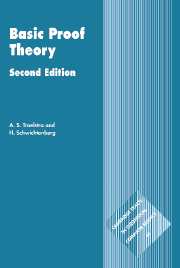Book contents
- Frontmatter
- Contents
- Preface
- 1 Introduction
- 2 N-systems and H-systems
- 3 Gentzen systems
- 4 Cut elimination with applications
- 5 Bounds and permutations
- 6 Normalization for natural deduction
- 7 Resolution
- 8 Categorical logic
- 9 Modal and linear logic
- 10 Proof theory of arithmetic
- 11 Second-order logic
- Solutions to selected exercises
- Bibliography
- Symbols and notations
- Index
3 - Gentzen systems
Published online by Cambridge University Press: 05 June 2012
- Frontmatter
- Contents
- Preface
- 1 Introduction
- 2 N-systems and H-systems
- 3 Gentzen systems
- 4 Cut elimination with applications
- 5 Bounds and permutations
- 6 Normalization for natural deduction
- 7 Resolution
- 8 Categorical logic
- 9 Modal and linear logic
- 10 Proof theory of arithmetic
- 11 Second-order logic
- Solutions to selected exercises
- Bibliography
- Symbols and notations
- Index
Summary
Gentzen [1935] introduced his calculi LK, LJ as formalisms more amenable to metamathematical treatment than natural deduction. For these systems he developed the technique of cut elimination. Even if nowadays normalization as an “equivalent” technique is widely used, there are still many reasons to study calculi in the style of LK and LJ (henceforth to be called Gentzen calculi or Gentzen systems, or simply G-systems):
Where normal natural deductions are characterized by a restriction on the form of the proof – more precisely, a restriction on the order in which certain rules may succeed each other – cutfree Gentzen systems are simply characterized by the absence of the Cut rule.
Certain results are more easily obtained for cutfree proofs in G-systems than for normal proofs in N-systems.
The treatment of classical logic in Gentzen systems is more elegant than in N-systems.
The Gentzen systems for M, I and C have many variants. There is no reason for the reader to get confused by this fact. Firstly, we wish to stress that in dealing with Gentzen systems, no particular variant is to be preferred over all the others; one should choose a variant suited to the purpose at hand. Secondly, there is some method in the apparent confusion.
As our basic system we present in the first section below a slightly modified form of Gentzen's original calculi LJ and LK for intuitionistic and classical logic respectively: the Gl-calculi. In these calculi the roles of the logical rules and the so-called structural rules are kept distinct.
- Type
- Chapter
- Information
- Basic Proof Theory , pp. 60 - 91Publisher: Cambridge University PressPrint publication year: 2000

